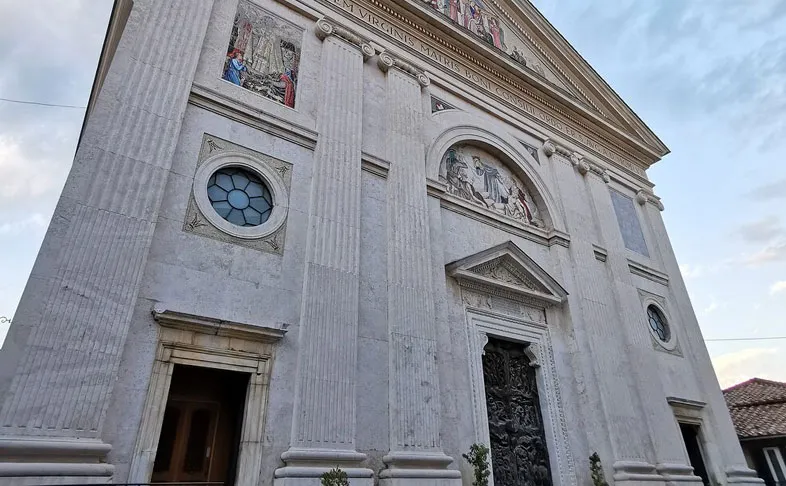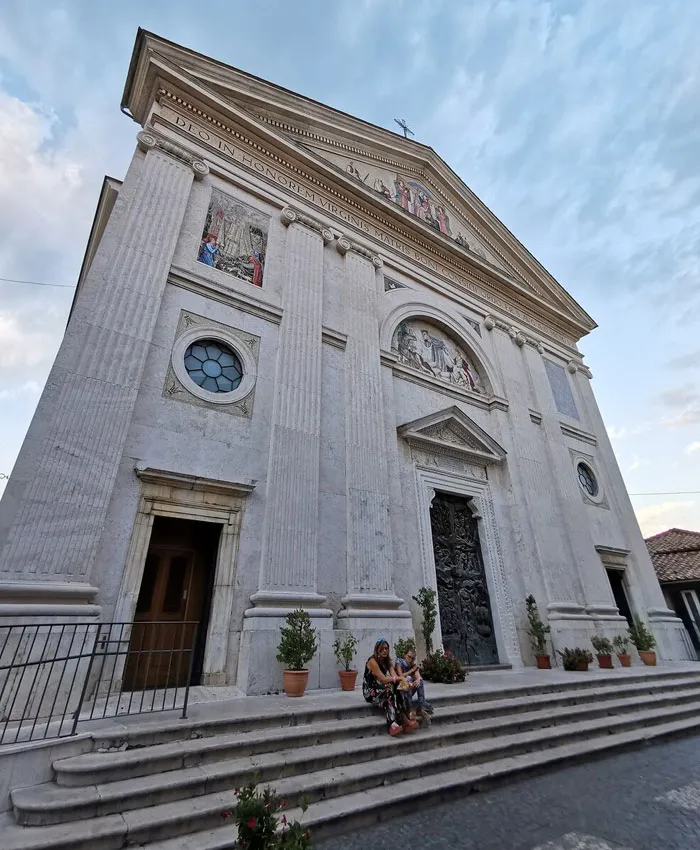
Introduction
The Sanctuary of Our Lady of Good Counsel is located in Genazzano, in Lazio, Rome, Italy. In the 15th century it became the destination of numerous pilgrimages since, miraculously, an image depicting the Madonna and Child came off a fresco from a church in Shkodër, an Albanian city, during the siege of the Ottoman Turks.
On March 17, 1903, Pope Leo XIII elevated the sanctuary to the dignity of a minor basilica. From 1826 to 1840 the now blessed Stephen Bellesini was parish priest of the sanctuary. The construction work began in 1467, when Petruccia, widow of Giovanni di Nocera, was subsequently blessed at the behest of Pope Clement XIV.
It is reported in the work of Ambrogio da Cori the work written in 14 78 by Bishop Michele Canensi: Life of Paul II that Pope Paul II sent, in the same year of his arrival, two bishops: Gaucerio de Forcalquier, bishop of Gap (France) and Nicola de Crucibus, bishop of Hvar (Dalmatia), to ascertain the truth of the facts.
It is not known exactly when the inspection took place but from the Libri Camerales, therefore official documents, indicate the date of the mission between April 25 and July 24, when the travel expenses were paid. There is no information on the drafting of an official document, but it can be deduced that no irregularities or falsehoods were found as there continued to be pilgrimages and donations to the Sanctuary.
In the Augustinian world, the hill town of Genazzano, about an hour from Rome by car, is well known. The Order of Saint Augustine came there not long before the year 1274. The church at Genazzano, where the Order of Saint Augustine has served since 1356, is most famous for a small fresco of the infant Jesus and his mother. The fresco gives Mary the title of the Mother of Good Counsel. The image below is a fairly accurate copy of the fresco and its decorative jewellery.
It is the most famous fresco in Augustinian possession. The Christ Child nestles close to his mother. Mary supports Jesus with her left arm. She bends her head toward him, and their cheeks touch tenderly. The left hand of Jesus gently grasps the rim of her dress, indicating the intimacy of nursing. Measuring approximately 15.5 inches by 17.5 inches, the fresco is executed on a thin layer of plaster or porcelain not much thicker than paper. One writer describes it as a fresco painted on a material resembling egg shell.
When restoration of the church was undertaken in 1957, scientific tests established that the fresco was probably painted sometime between 1417 and 1431 by the Italian artist, Gentile de Fabriano. It appears to have been part of a larger fresco that covered most of the church wall. An earlier legend that reported the fresco discovered – or miraculously “appearing” – in 1467 to a local widow named Petruccia de Geneo can be explained by the likely case of the fresco having had paint or plaster placed over it previously.
That the appearance of the fresco in 1467 was “miraculous” was promoted by the Provincial of the Augustinian Roman Province at that time. He was Ambrose Massari da Cori O.S.A., who stated in his book, Chronica, in 1482 that the fresco had been carried by angels to Genazzano from Scutari in Albania.
What is certain, however, is that the fresco immediately began to be a focus for pilgrims devoted to Mary in central Italy. This Augustinian church became one of the most popular Marian sanctuaries in central Italy, and remains so right up to the present day. Pope Urban VIII visited the Genazzano sanctuary in 1630, and in 1779 Pope Pius VI approved a Mass and Divine Office for the feast of the Mother of Good Counsel.
The devotion of Leo XIII (Pope from 1878 to 1903) to Mary under the title of Mother of Good Counsel has become proverbial especially because of his words, saying of that pontiff: “Children, follow her counsels.”
History of Sanctuary of Our Lady of Good Counsel, Genazzano

In the place where today stands the Basilica of the Mother of Good Counsel there was an ancient church dedicated to the Virgin Mary since the 11th century. In the year 1356 the church was entrusted by the Colonna, lords of Genazzano, to the Augustinian friars who lived in a small convent outside the walls from the seventies of the thirteenth century. The notarial deed drawn up upon delivery who informs that the church was a parish and was already called S. Maria del Buon Consiglio.
In the second half of the 15th century, an Augustinian widow and tertiary named Petruccia, who has always been venerated as a blessed, made all her possessions available to rebuild the old church, small and dilapidated. However, the resources were not sufficient and the works were suspended. Petruccia’s fellow citizens began to mock her, but the pious woman replied: “My children, do not worry, because before I die (and she was already very old) the Blessed Virgin Mary and Saint Augustine will finish this church”.
According to a very ancient tradition, it was not long after Petruccia’s prediction that on April 25, 1467, the feast of St. Mark, around the time of vespers, an image of the Blessed Virgin Mary miraculously appeared on a wall of the church in construction. The population remained stuttered not only for the prodigious event, but also and above all for the numerous miracles performed by the Blessed Virgin Mary, manifested in that beautiful Image of her.
The graces and miracles received by the citizens of Genazzano and many other cities of Lazio were recorded by a notary and then they were transcribed in a special register kept until the nineteenth century (the so-called Bombacino Code, i.e. paper, or Code of Miracles). Between 27 April and 14 August 1467 alone, 161 miracles were recorded.
Not long after the miraculous event, two Albanian pilgrims recognized in the features of the Madonna di Genazzano the image venerated in Scutari in Albania which, in a no less miraculous way, had detached itself from the place where it was venerated and had abandoned those lands that in a short time would have fallen into the hands of the sultan. Even today this tradition is alive, both in Genazzano which celebrates the “Coming” of the Holy Image on April 25 every year.
Continuously, from the fifteenth century to today, the mystical and maternal presence of Mary has never ceased to attract pilgrims from everywhere and the sanctuary of Genazzano, considered a small “Loreto” of Lazio, is visited by thousands of Italian pilgrims every year and foreigners who bear witness to a grateful sonship to the Mother of the Lord.
Architecture of Sanctuary of Our Lady of Good Counsel, Genazzano
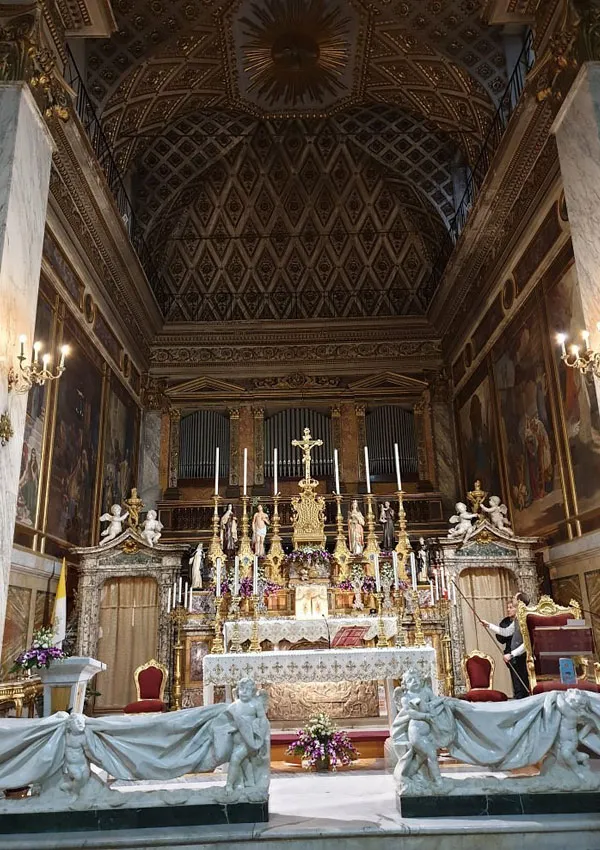
One of the famous pictures of Pope Leo XIII is the one taken beneath a picture of Our Mother of Good Counsel. Whence came the Pope’s devotion to the Mother of Good Counsel? Perhaps it was through his Augustinian confessor, the Papal Sacristan, Bishop William Pifferi O.S.A., himself an ardent apostle of this Marian devotion. We may sum up the devotion of Leo XIII to the Augustinian Madonna by quoting from the Decree of 22nd April 1903, which announced the inclusion of the invocation to Our Mother of Good Counsel in the Litany of Loreto:
“… Likewise, with the Apostolic See approving, the Blessed Virgin Mary has been saluted with the title Mother of Good Counsel from ancient times both by clergy and Christian laity, asking for her aid.
Our Holy Father Pope Leo XIII, on account of his own, and on account of the singular piety of the faithful towards Our Mother of Good Counsel and her Sacred Image which is particularly cherished at the sanctuary at Genazzano, after he had conceded through the Sacred Congregation of Rites a new Office with a Mass for the feast in 1884, in the year 1893 he also granted a proper Scapular with indulgences; and at the turn of this year 1903, he also erected through Apostolic Letters in the form of a Brief, the Sanctuary at Genazzano to the grade of Minor Basilica with all the privileges of such a rank, having previously enlarged the guest house there from his own money.”
“Finally, this same pontiff, in order that the afore mentioned title may increase the honour and cult of the Blessed Virgin, having consulted the Sacred Congregation of Rites, has stated and decreed that in the Litany of the Blessed Virgin Mary, after the invocation Mother Most Admirable, there be added Mother of Good Counsel, Pray for us.
Moved also by this thought, and by the firm hope that in so many trials and calamities of these days, Our Lady, who is called by the Fathers the treasury of heavenly graces and universal counsellor, petitioned by the whole Catholic world under this title, may show herself to be our Mother of Good counsel, and may she obtain for us that grace of the Holy spirit, which will illumine our senses and our hearts, and may she obtain for us the holy gift of Counsel.”
With the Pope himself thus expressing his devotion to the Augustinian Madonna, it was only natural that the Order should show its appreciation by greater devotion to the Mother of Good Counsel. Pamphlets, books and periodicals in Italian, Spanish, Belgian, German and English began to appear under Augustinian auspices.
A subsequent intense artistic scrutiny of the fresco led to the discovery of what appeared to be an artist’s name disguised on the edge of the dress of the Infant, which seemed to be A. VIVA…. – FECIT, written upside down. By proposing the letters that were unable to be read, this was interpreted to be A. VIVARINI – FECIT, which is Latin for A. Vivarini made this. Anthony Vivarini (born – 1410, died – 1476) was a Venetian painter. He was a master of the Veronese school of art in the first half of the fifteenth century. Nothing is known about Vivarini before he became famous in 1440, hence his painting the Genazzano fresco before 1440 is feasible.
Art experts agree that the style of the fresco is that of Italian art of that post-Gothic but pre-Renaissance period and, furthermore, could be an early work of Vivarini. Two of his earliest-known works are from the year 1441, and are at the Galleria dell’ Academia in Venice. One of them is called Virgin and Child, and is reproduced (at top right). It bears some resemblance to the Genazzano fresco. Another of Vivarini’s works of 1414 is The Marriage of St Monica.
Our Lady of Good Counsel
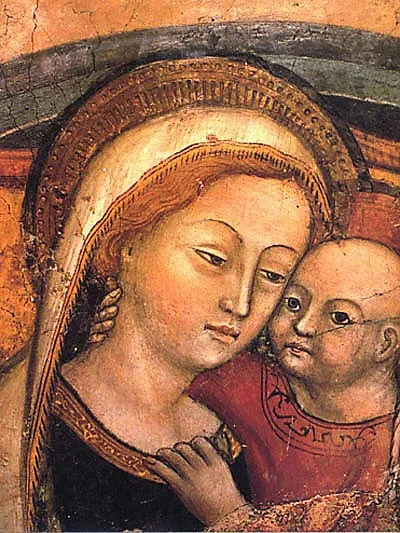
Our Lady of Good Counsel is a title given to the Blessed Virgin Mary, after a painting said to be miraculous, now found in the thirteenth century Augustinian church at Genazzano, near Rome, Italy. Measuring 40 to 45 centimetres (16 to 18 in) the image is a fresco executed on a thin layer of plaster no thicker than an egg shell. Over the centuries, devotions to Our Lady of the Good Counsel grew among saints and Popes, to the extents that a reference to it was added to the Litany of Loreto and the devotion spread throughout the world.
In the 5th century, during the reign of Pope Sixtus III, the town of Genazzano, about 48 kilometres (30 mi) south of Rome, had contributed a large portion of its revenue for the Roman basilica now known as Santa Maria Maggiore. In appreciation, a church, called Santa Maria, was built in Genazzano and was later entrusted to the Augustinian Order in 1356. The Genazzano church became a popular place of pilgrimage. Numerous cures were said to take place there. The Augustinian friars were invited to minister to the spiritual needs of the pilgrims. They continue to serve there to this day.
The picture of Our Mother of Good Counsel is familiar to all who frequent the churches of the Augustinian friars. With them and their people it has a place of special honor. The original, the miraculous picture, has been in the reverent keeping of the members of the Order of Saint Augustine for over four hundred years. The church that enshrines the original fresco of Our Mother of Good Counsel is located in the small town of Genazzano, Italy.
Our Mother of Good Counsel by P. Sarullo. Legend has it that this church stood unfinished and roofless when, on 25 April 1467, the image of the Madonna was miraculously transported there from its former home in Scutari, Albania. Coming to rest precariously on a narrow stone ledge in the wall inside the church, the legend continues, the picture has remained in that position to the present day.
The name, however, is much older than the picture. “Saint Mary of Good Counsel” was the name given to a beautiful little church erected in the fifth century on the ruins of a temple of Venus in ancient Latium. But time took its toll on the church. It was almost a ruin in 1356, when the Augustinian friars were charged with its care and restoration. The task might have been hopeless if Mary herself had not come with her heavenly image in 1467. She seemed determined to confirm and perpetuate her favorite title, “Mother of Good Counsel.”
Careful investigations undertaken between 1957 and 1959 for the purpose of restoration have revealed something of the true origin of the fresco. The image of the Madonna about 12 inches wide and 17 inches high that the viewer today sees encased in an elaborate glass, metal, and marble framework is part of a larger fresco that once covered a portion of the wall now hidden by the baroque shrine altar.
Art experts consulted during the restoration suggest that the fresco, including the image of the Madonna, is the work of the early fifteenth century artist Gentile da Fabriano. He probably painted his fresco on the wall around the time of Martin V (1417-1431). At some subsequent date before 1467, the fresco, so it is surmised on the basis of the evidence, was covered over with plaster, and on the wall was hung a terracotta image of the Madonna which was known as Our Mother of Good Counsel.
History of Our Lady of Good Counsel

In 1467 the Augustinian friars began rebuilding the church on the site, enclosing within the structure the wall on which the then covered fresco was painted. This work was sponsored by a widow named Petruccia, who exhausted her means on the project and was unable to continue the construction. At that point the image of the Madonna appeared and was taken to be a token of divine favor.
The unexpected appearance was perhaps brought about in this way: when the stone ledge was being inserted into the wall, the plaster covering cracked and separated from the wall, revealing the fresco beneath. The image was initially hailed as the Madonna of Paradise, an allusion to its apparently heavenly origin, but soon it came to be known by the former title of the shrine, Madonna of Good Counsel.
The unfinished church was completed soon after this occurrence and became the center of continuous pilgrimage. A place was also built for the Augustinian friars, who to this day still minister to the spiritual wants of the thousands that come to venerate the picture of the Mother of Good Counsel. The story of the picture spread far and wide; many came to pray at this shrine. The numerous cures recorded as having occurred since then have caused the picture of the Madonna to be called miraculous.
One striking aspect of the fresco, which has lent a certain credence to the legends surrounding it, is that the upper portion of the image is separated from the wall so that much of the fresco is just a thin sheet of plaster. Yet the image of Our Lady of Good Counsel has survived for centuries in this precarious state, through the rebuilding of the main walls of the church, through a number of earthquakes, and even through the aerial bombardment of Genazzano during World War II. Because of this condition, the restoration undertaken in 1957 was a delicate task.
There arose a legend that the picture had come from Albania, many miles across the Adriatic Sea. Among the first pilgrims who came to Genazzano were two men with a very remarkable story to tell. While praying at a shrine of Our Lady in the Albanian town of Scutari they saw the picture which they were venerating remove itself from the wall of the church. They watched in amazement as it rose into the air. High in the sky it was wrapped in a cloud and vanished from their sight in the direction of the Adriatic and Italy.
They tried to follow the image. They searched everywhere for it, in all the famous shrines and churches of Rome and other cities. Finally they heard rumors of a new picture at Genazzano. They hurried there and at last found the object of their quest, their own beloved holy picture. At Scutari it had been loved and revered for many centuries; then the ardor of the people toward it had cooled.
In their very early endeavors the good friars were ably assisted in their efforts by the gracious aid of a holy widow, Petruccia di Nocera. Since her husband’s death, this saintly woman, a tertiary of the Order of Saint Augustine, had devoted herself to the service of the little church, and great was her distress over the neglected condition in which the sanctuary of Our Mother of Good Counsel was permitted to remain.
To restore it was the ambition of her life, and so strongly was she drawn to the undertaking that she felt inspired to sacrifice her home and moderate income to further this cause. While others might have felt daunted, Petruccia never once faltered in her hopes. She constantly reiterated her assurance that the work would be completed because Almighty God, through the intercession of Saint Augustine and the Blessed Virgin, would see fit to crown her feeble efforts with unforeseen success.
Petruccia, having lived to see her fondest hopes abundantly realized, died in 1470, honored by all. The Augustinians who owed so much to this good tertiary laid her body to rest at the feet of the beloved Madonna, with an inscription above which told of her share in the great work accomplished by God at Genazzano.
Our Mother of Good Counsel has been called the Madonna of the popes. In truth, since the arrival of the picture, there is scarcely a pope who has not in some way shown great devotion to her. The initial approval of the devotion to Our Mother of Good Counsel was given by Pope Paul II. In 1753 Pope Benedict XIV established the Pious Union of Our Lady of Good Counsel, a spiritual society to which many indulgences were attached. Pope Pius IX had a personal devotion to Our Mother of Good Counsel; he made a pilgrimage to Genazzano in 1864.
More than any other pope, Pope Leo XIII, himself a member of the Pious Union, was deeply attached to this devotion, which had associations with his childhood in Carpineto, a town not far from Genazzano. He instituted the white scapular of Good Counsel, inserted the title Mother of Good Counsel into the Litany of Loreto, declared the shrine a minor basilica, and installed a copy of the image over the altar in the Pauline chapel in the Vatican. It was he who coined the phrase: “Children, follow her counsels.” Pope Pius XII dedicated his reign to Our Mother of Good Counsel, and Pope John XXIII made a visit to her shrine in 1959.
The Augustinians have been at all times the outstanding promoters of the devotion to Our Mother of Good Counsel. Within the last century there have been two holy men of the Order who were particularly notable for their zeal in spreading this devotion. Blessed Stephen Bellesini was pastor at the shrine and is buried in a side chapel of the church, and Venerable Joseph Menochio was papal sacristan to Pope Pius VII.
Thus, for five hundred years, the devotion to Our Mother of Good Counsel has flourished and grown. Great artists have fashioned rich copies of the Madonna in canvas, stone, and mosaic. One will find the picture of Our Mother of Good Counsel in beautiful shrines and in great cathedrals and churches. Missionaries have carried it to the ends of the earth, and it has found its way into the humblest of homes throughout the world.
Legend
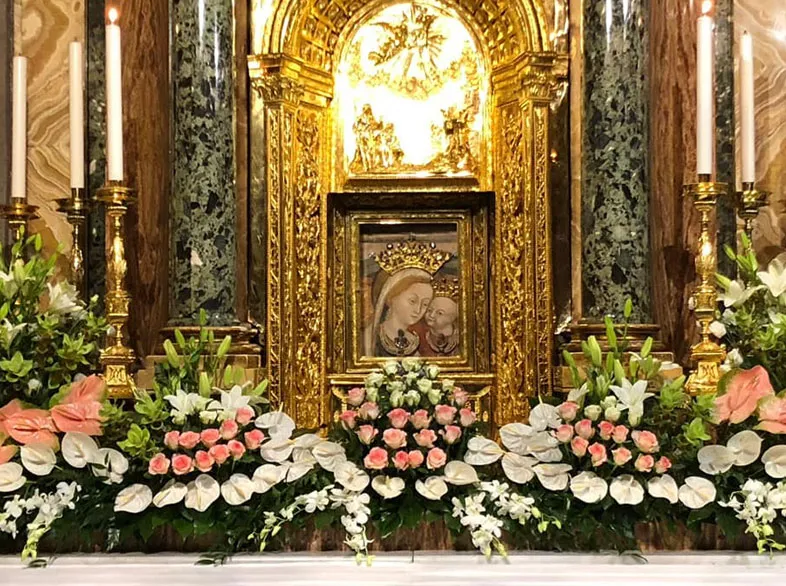
According to tradition, the story is said to have begun in 1467. By then the church was in dire need of repair. A local widow, Petruccia, was dedicated to the restoration project, but ran out of funds before the task was completed.
In the midst of the festivities for the Feast of Saint Mark, the townfolk suddenly heard “exquisite music.” A mysterious cloud was then said to have descended on the unfinished wall of the parish church. In front of the people, the cloud dissipated and a beautiful fresco, no thicker than a carte-de-visite and no more than eighteen inches square, of the Virgin Mary and the Christ Child was revealed. It was widely believed that it had been miraculously transported from a church in Scutari, Albania just prior to its invasion by the Ottomans.
The picture of Our Lady was at first called “La Madonna del Paradiso” and now better known as “Madonna del Buon Consiglio” (Our Lady of Good Counsel).
Such was the holy image’s reputation that Pope Urban VIII made a “glittering” pilgrimage there in 1630, invoking the protection of the Queen of Heaven, as did Pope Pius IX in 1864. On 17 November 1682, Pope Innocent XI had the picture solemnly crowned. Among her noted clients have been St Aloysius Gonzaga, St Alphonsus Liguori, St John Bosco, and Blessed Stephen Bellesini.
Veneration
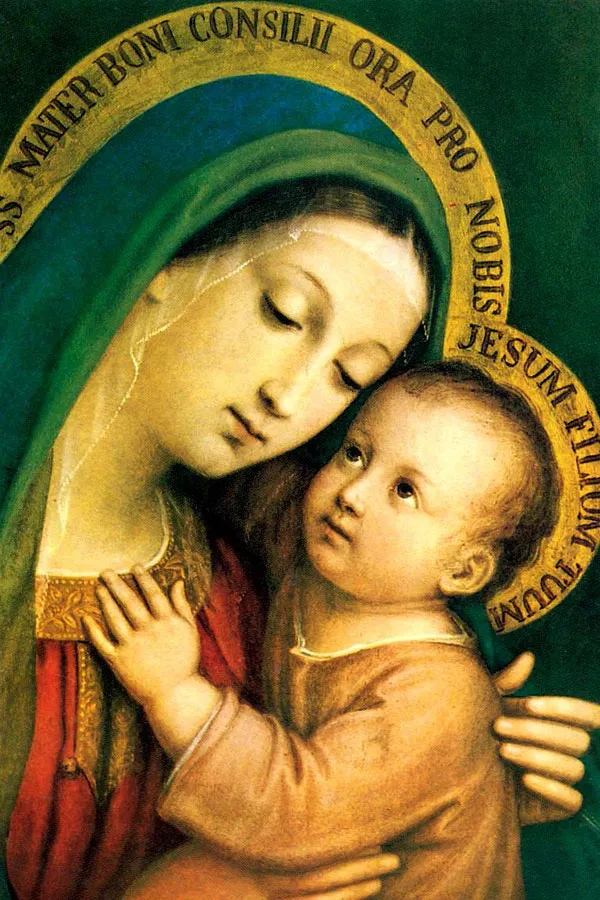
The Augustinian Order contributed to the spread of this devotion internationally. In 1753, Pope Benedict XIV established the Pious Union of Our Lady of Good Counsel. Leo XIII, who was himself a member of the pious union, was deeply attached to this devotion.
On 22 April 1903, Pope Leo XIII included the invocation “Mater boni consilii” in the Litany of Loreto. In 1939, Venerable Pope Pius XII placed his pontificate under the maternal care of Our Lady of Good Counsel and composed a prayer to her.
Through the years, various institutions have been named in honor of Mary under the title of Our Lady of Good Counsel. These institutions include a college, high schools, and churches.
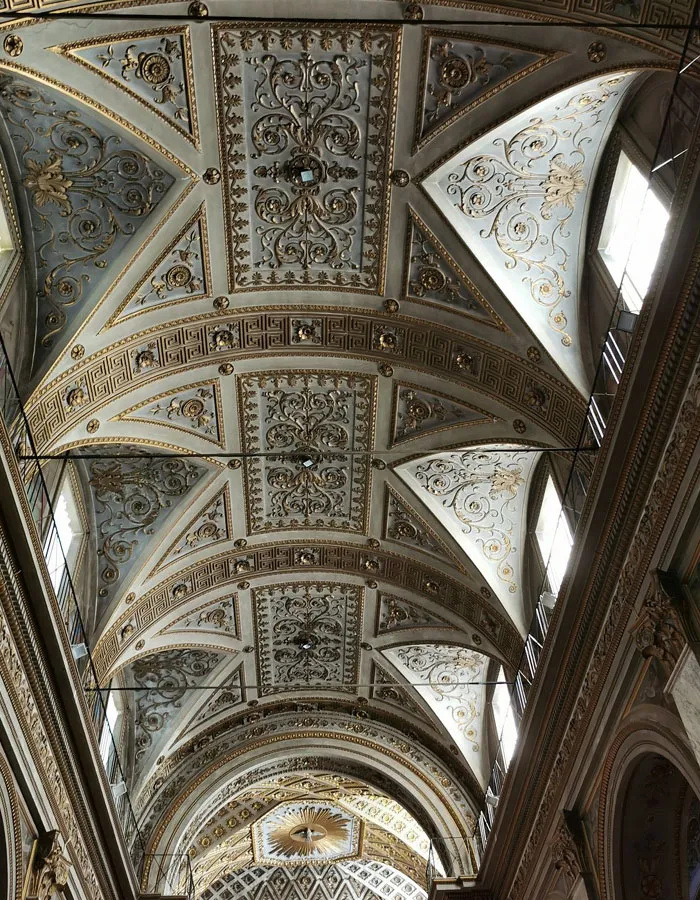
The White Scapular
The small Scapular of Our Lady of Good Counsel (the White Scapular) was presented by the Hermits of St Augustine to Pope Leo XIII, who, on 19–21 December 1893, approved it and endowed it with indulgences in a Decree of the Congregation of Rites.
On the front panel of the sacramental (to be made of white wool) is the image of the fresco of Our Lady of Good Counsel, with the inscription, “Mater boni consilii [ora pro nobis].” On the second segment is found the papal coat-of-arms, which includes the Triple Tiara and the Keys of Heaven, with the words of Leo XIII: “Fili acquisce consiliis ejus” (Child, listen to her counsels).
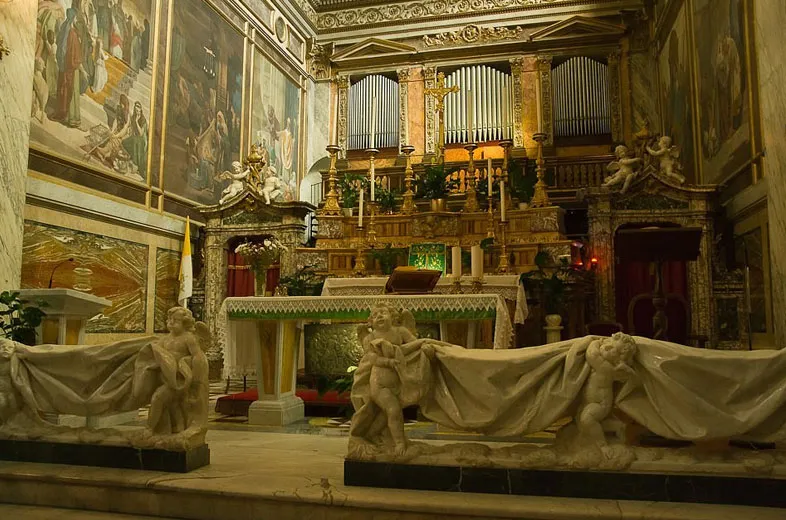
Patronage
Our Lady of Good Counsel is the Patroness of the Missionary Sisters of Saint Peter Claver, the National Council of Catholic Women, and of the Catholic Women’s League of Canada.
The “Midwest Augustinians” headquartered in Chicago have also adopted Our Lady of Good Counsel as their patroness, having named their Augustinian jurisdiction as the “Province of Our Mother of Good Counsel.”
The town Essen in the German Ruhr- Area is under the patronage of the Lady. The High church the Münster of Essen as it is called was given to her after the Ruhrbistum was established.
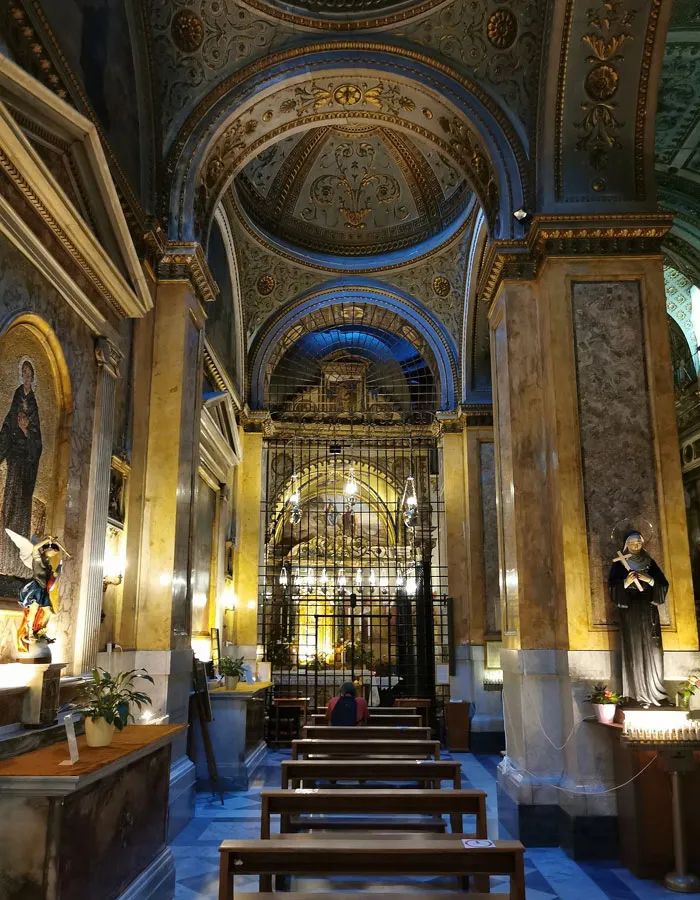
Feast Day - 26th April
Annual Feast Day of Our Lady of Good Counsel held on 26th April.
Church Visiting Time
- Every Days on Winter: 7:00 am to 12:45 pm & 3:00 pm to 6:45 pm
- Every Days on Summer: 7:00 am to 12:45 pm & 3:00 pm to 7:45 pm
Contact Info
Basilica Sanctuary Mother of Good Council,
2, Corso Cardinali Vannutelli,
00030 Genazzano, Rome, Italy
Phone No.
Tel : +39 06 95 79 002
Accommodations
How to reach the Sanctuary
Ciampino International Airport “G. B. Pastine”, at Rome, Italy is the nearby airport to the Sanctuary.
Repubblica Metro Station in Rome, Italy is the nearby Train Station to the Sanctuary.

